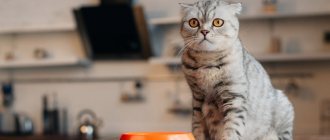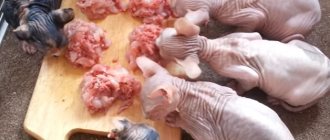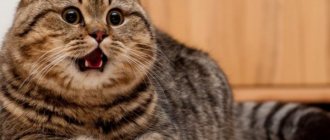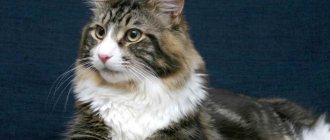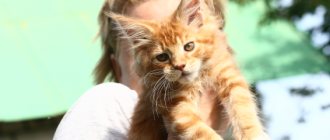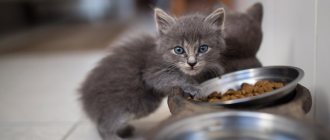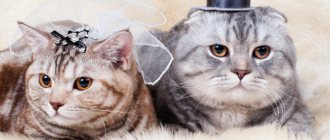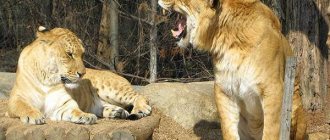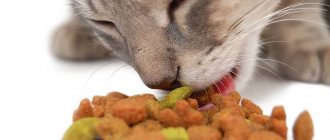What is natural cat food?
The Natural Cat Nutrition System is a diet specifically formulated for cats that meets their basic nutritional needs. It is based on the adaptation of modern products to the historical diet of animals, consisting mainly of meat, fish and offal.
Our furry pets are relatives of predators. It is believed that natural nutrition is more physiological for the cat’s gastrointestinal tract and ensures the full development and growth of the body.
Basic rules for organizing natural food for cats:
- Choose only proven products. You should not skimp on meat or fish: before cooking, be sure to inspect them for freshness and the presence of various worms and other parasites. Vegetables should also be purchased from markets or private farmers, as they contain fewer harmful additives.
- When cooking, you should use boiling, stewing or baking: fried food is harmful to cats. Some foods can be served raw or frozen. Hard and dense food should be cut into small pieces to prevent the animal from choking.
- Food should be moderately warm. Regularly eating food that is too hot or too cold can cause problems in the digestive system.
- It is necessary to alternate different products. A cat's diet should not consist of only meat or fish: such food quickly becomes boring and does not provide the required amount of nutrients. Experiment with your pet's menu: this will help you find out his taste preferences.
Table: pros and cons of natural feeding
| Advantages | Flaws |
| The ability to independently model your pet’s diet | Fresh food must be prepared daily |
| Constantly providing your cat with fresh food | You cannot leave food for several days at once, as is the case with dry food. |
| The animal does not suffer from fluid deficiency, since it is contained in sufficient quantities in the food. | Vitamins and mineral complexes should be periodically added to foods (as recommended by a veterinarian) |
| Normal functioning of the cat's gastrointestinal tract | The difficulty of creating a balanced menu from natural products (it is difficult for a person without specialized education to take into account all the nuances) |
| Less strain on the teeth (the animal does not have to chew dry food) | |
| A properly formulated diet of natural products can be used for various diseases |
How to accustom a cat to new food
When changing your diet, a smooth transition is necessary. This way you can avoid digestive disorders.
Rules for transferring to a new diet:
- gradually reduce portions of the previous food;
- increase the amount of natural product;
- for training, use one recipe for homemade food, only after getting used to it, add new products;
- During the first days you should monitor your pet; if digestive problems arise, change the components of the homemade food;
- if you have a poor appetite, it is permissible to feed by hand or warm it up to a slightly warm state (the cat is a predator and for it the normal food temperature is the temperature of a freshly killed carcass).
You can switch the animal to natural food within 1-2 weeks.
Feeding rules
To keep your animal healthy, it is important to follow basic nutritional rules:
- The pet should be fed at the same time, 2-3 times a day. Kittens should be fed 5-6 times a day.
- Provide access to water around the clock.
- If symptoms such as vomiting, diarrhea, lethargy, or fever appear, contact your veterinarian immediately.
- After eating, the cat often requires rest; you should not disturb it.
- Uneaten food must be disposed of - it quickly deteriorates and becomes dangerous for the animal, in addition, with constant access to food, cats can overeat.
It is better to discuss the composition of homemade food with your veterinarian. He will suggest the most balanced types of nutrition, taking into account the characteristics of the pet. Food for kittens, adult cats or sterilized animals differs in composition. All ingredients must be fresh and of high quality.
Expert recommendations for choosing a nutritious diet
Veterinarians are also positive about formulating a diet for cats based on natural products. Currently, the BARF (Biologically Appropriate Raw Food) system is widely used in Europe and America. It was invented in the nineties of the last century by veterinarian Ian Billinghurst from Australia. However, feeding only raw foods is associated with certain risks for the health of cats, so our doctors adhere to the need for heat treatment.
Video: veterinarian talks about the correct natural diet of an animal
What components must be present in a cat's diet?
A balanced diet includes proteins, fats, carbohydrates and vitamin-mineral complexes. Their quantity and daily calorie intake are determined based on data on the cat’s age and weight: for this purpose, it is recommended to use reference tables.
Based on these data, you can calculate the amount of necessary components in the diet.
What foods should be included in a cat’s diet:
- Meat, poultry and meat products are the main source of protein and essential amino acids. They should be served raw (exclusively after freezing), boiled or stewed. It is recommended to use lean beef, lamb, rabbit, chicken and turkey to feed your cat. Lamb, pork, duck and quail are too heavy for the animal's stomach, as they contain a lot of fat. Among meat products, preference should be given to ventricles, hearts and liver.
- Fish contains lipids, amino acids, phosphorus and magnesium. It is recommended to use sea fish to feed cats: unlike freshwater fish, it does not accumulate toxic substances in its composition. Fish should be given boiled, after removing the head, fins, tail, scales and all bones: these components are not digested in the stomach. The most useful fish include: pink salmon, hake, salmon, trout, taimen.
- Butter and vegetable oil are essential sources of fats and vitamin E, help strengthen vascular walls and increase resistance to infections. A lack of fat in an animal's diet can lead to reproductive dysfunction. Oil should be added to food in an amount of no more than half a teaspoon.
- Dairy products and eggs. Dairy products are rich in calcium and protein and are easily digestible by your pet's body. These include kefir, fermented baked milk, natural yoghurts without additives, cottage cheese, sour cream. Mostly the yolk is used from eggs for cat diet: it contains the required amount of fat.
- Porridges and cereals act as a source of slowly digestible carbohydrates. To feed your furry pets you should use buckwheat, oatmeal or rolled oats, millet, rice, boiled in water. It is better to avoid semolina porridge: it has no nutritional value and contains only empty carbohydrates.
- Vegetables are not only a source of healthy vitamins, but also fill the need for fiber. It improves the functioning of the gastrointestinal tract and stimulates digestion processes. Vegetables need to be boiled, baked or ground into a paste using a blender. Most often, cats' menu includes pumpkin, zucchini, broccoli, carrots, and beets. Cabbage, potatoes, legumes and peas cause excessive gas formation, so they are not used. You can use spinach, green onions, celery, and basil as healthy additives.
Cats can often develop interesting taste preferences. The cat of my grandmother, who lived in the village, loved raw cucumbers very much and regularly stole them from the garden. The fluffy pet could handle a whole cucumber alone and never refused a supplement. My sister's cat really loves bananas and melons, but since they contain a lot of sugar, the animal manages to enjoy them only occasionally.
Photo gallery: healthy food for pets
Meat should be served cut into small cubes Dairy products are rich in calcium
Cereals satisfy the need for slow carbohydrates Vegetables are the best source of fiber and vitamins
What foods should you avoid altogether?
Some foods and additives familiar to humans are strictly prohibited from being used in the diet of cats. The body of furry pets is much more sensitive to various food components. An incorrectly formulated diet can lead to the development of serious diseases of the liver, stomach, bones and joints, or even cause premature death.
What should not be added to a cat's diet:
- Ketchup, mayonnaise, adjika and any other sauces. They contain a lot of spices and can also be very salty and spicy. If you think that the dish prepared for your pet is dry, it is better to dilute it with sour cream or meat broth.
- Meat trimmings, chicken skin, chicken bones. These leftovers do not provide any nutritional value, but can become ballast for your pet's digestive system. Sharp edges of bones and their fragments can injure a cat's delicate gastrointestinal tract.
- Sausage, frankfurters, sausages, stewed meat, meat pates. These products are more adapted to the human diet: they contain many third-party additives and soy, but they cannot replace real meat.
- Sweet yoghurts, snowballs, condensed milk, ice cream. Despite the fact that these products also belong to the dairy category, they contain too much sugar. It has been proven that even minor consumption of condensed milk creates a risk of damage to the pancreas and the development of diabetes in cats.
- Floury. Bread, any pastries and cookies are poorly absorbed in the body of a furry pet and provoke constipation.
- Tea. Many owners are touched when their cat drinks the rest of the tea from their mug. However, tea (especially black tea) contains caffeine, which has a stimulating effect on the animal’s nervous system and leads to the development of restless behavior and hyperactivity.
While studying at the university, in one of the classes on clinical laboratory diagnostics, we studied the composition and properties of urine using the example of cat urine. One of my classmates collected urine from her cat and brought this sample to class for research. Our teacher conducted several tests with special strips that detect the presence of glucose in urine: they turned out to be positive. It turned out that the day before, a classmate fed her cat sweet yogurt: this caused a sharp jump in sugar levels in the animal’s body. The teacher recommended reconsidering the furry pet’s diet and giving up such food forever.
Photo gallery: prohibited products for animals
Sausages contain a lot of soy and third-party additives
Flour slows down your cat's digestion
Mayonnaise contains a lot of fat
When not to give rice
Unfortunately, not every pet is in excellent health. Accordingly, each owner should make his own decision about which foods to include in the cat’s diet and which not.
If an adult animal suffers from constipation, feeding it this grain is strictly prohibited - you will only worsen the situation. Also, you should not give porridge to kittens, since their digestive system has not yet formed and is not fully strengthened - it may not cope.
However, this cereal is well absorbed by the body, so it is better to evaluate each situation separately. And preferably with the accompanying supervision of a veterinarian.
Natural homemade food recipes for furry pets
Dishes for your cat can be not only healthy, but also varied. You can prepare your pet’s main meal, desserts and various pleasant treats yourself.
Many dishes prepared in this way can be poured into containers or placed in special bags and frozen. This way you will save yourself from lengthy cooking and provide your cat with a supply of food for a long time.
Recipes for preparing healthy dishes:
- Nutritious pate. Boil 0.5 kg of any meat for half an hour, then remove from the pan and add carrots and broccoli to the resulting broth. They must be cooked until half cooked. Pour boiling water over one glass of rolled oats and leave for 15 minutes, then pour out the water. Mix the meat with vegetables and oatmeal in a blender until it becomes a soft paste, add broth if necessary.
- Chicken gizzards with buckwheat. Pour half a glass of buckwheat porridge with water for a day. Boil chicken gizzards and one large carrot, then grind them in a meat grinder or using a blender. Add a small piece of butter to the porridge, pour in the gizzard and carrot pate.
- Millet porridge with turkey and vegetables. Boil small beets and carrots, peel and finely chop the raw zucchini. Divide the turkey into small pieces and cook millet porridge. Grind the vegetables together with the meat in a meat grinder, then add to the porridge. If necessary, you can dilute the dish by adding egg yolk.
- Lamb fillet with rice porridge. Grate freshly frozen lamb meat along with raw carrots. Boil the broccoli and rice in advance, then mix all the ingredients in a bowl with a small amount of olive oil.
- Beef with vegetable stew. Cut the boiled beef into small pieces, mix with baked pumpkin, stewed carrots and zucchini, pour in meat broth.
My cat really loves stewed liver: this dish ranks almost first among her taste preferences. The recipe is quite simple. Cut the liver into small pieces, grate the carrots, chop the green onions. Pour some water into a small frying pan, add all the ingredients and simmer for 20-25 minutes. It turns out to be a quite tasty and nutritious dish that can be mixed with any porridge.
How to prepare a healthy and tasty treat for your furry baby:
- Beef patties. On a fine grater, grate frozen beef (about 200 g), one large carrot, 3 lettuce leaves and 30 g of celery. Add 2-5 drops of olive oil and stir, then beat one egg into the mixture. Yandex Form thin flat cakes, place them on baking paper and bake at a temperature of about 140 degrees until they become golden brown.
- Curd balls. Take thick cottage cheese with 1-2% fat content, mix it with a few tablespoons of sour cream. Form small balls and place them in the refrigerator for a couple of hours to set.
- Chicken with cheese. Peel the skin from the chicken breast, then cut into small pieces. Place it in the oven at 150 degrees, grating no more than 1 tablespoon of hard, lightly salted cheese on top.
Meat mix
Any meat products in arbitrary proportions from those allowed are suitable for this dish. And the more of them, the better. For example: chicken breast, turkey and chicken stomachs, chicken heart. Everything is rinsed with cool water. Then the following are removed: from the hearts - pieces of fat, from the stomachs - hard connective fibers. After which the products are chopped into pieces measuring about 1 ╳ 1 cm. As in the case of heads and necks, the mixed cuts are placed in 200 ml portioned containers and sent for freezing.
Rating of the best treats
Today, pet stores offer many different animal foods, so it is often difficult to make a choice. There are some options to consider. So, what treats do cats like:
Felix
The originality of taste is inherent in Felix cat treats; it can be flavored with the most exclusive varieties of cheese and fish.
However, economy class treats are not the best way to please your pet.
Dreamies
Each Dreamies pouch contains two calories. It is recommended to give adult cats only a few pieces per day, approximately 4 pieces. per 1 kg of weight. Kittens should not be spoiled with this delicacy!
Village
This Russian-made product is available in various forms, including soap bubbles.
Rustic treats for cats are made from different types of meat products:
- Ducks;
- Salmon;
- Lamb.
No harmful or artificial substances are used in their production.
Orijen
There are clear reviews from veterinarians that cat treats should contain enough nutrients. One piece of Orijen delicacy contains three calories, as well as a vitamin complex enriched with minerals, and consists of almost one hundred percent meat. There are no grains. This delicacy belongs to the premium class.
Gimcat
The products are designed for each age and taking into account the physical condition of the animals.
Sanabelle
This product, in addition to its main beneficial properties, helps remove hair from the cat’s body.
There are series like:
- "Dental" is intended for oral care;
- “Vitality” - saturates with vitamins;
- "Hairball" - for the prevention of trichobezoars.
Edel cat
The German company offers to pamper the cat family with puree soups and chewable sausages. Cats eat sausages with contentment, and soups like puree are not high in calories.
